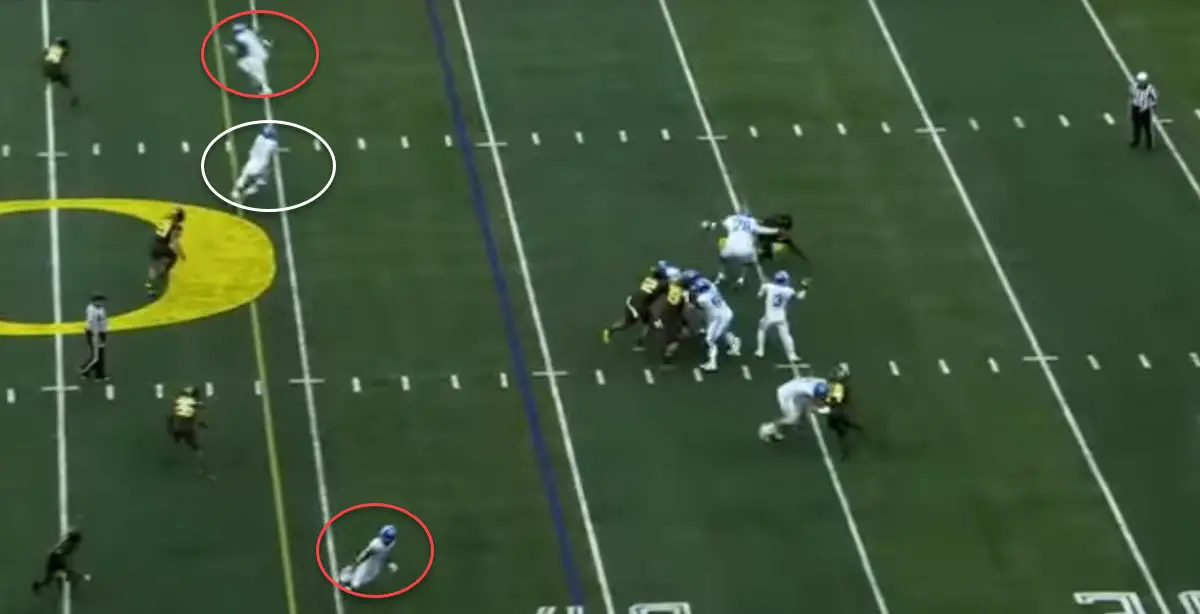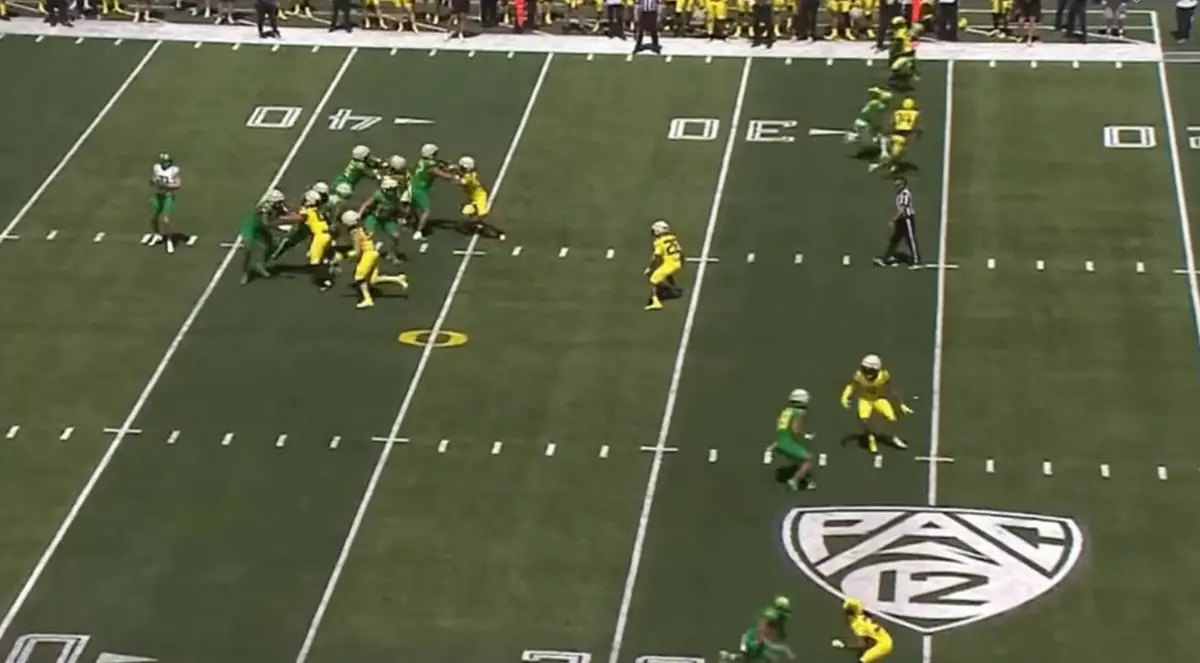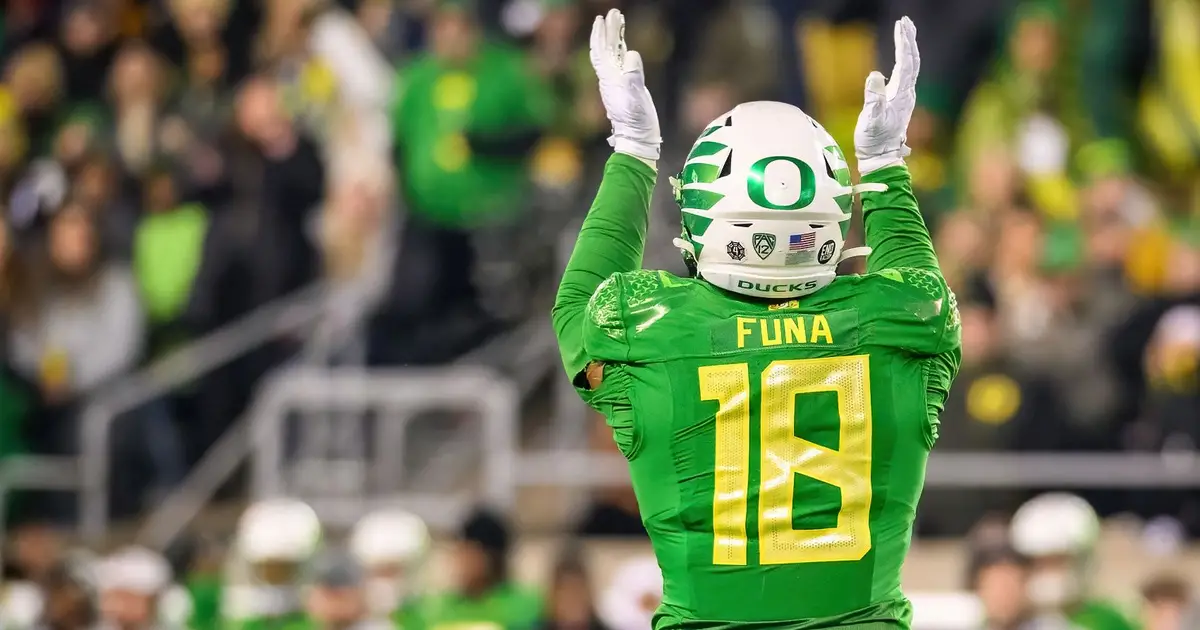The Oregon Ducks’ defense has maintained one major problem for the last three years. Simply put, it has a soft underbelly that has been the defense’s undoing.
In the zone of the field that is between the defensive front and the secondary, Oregon has been incredibly vulnerable for easy yards. Typically, not enough yards that result in touchdowns, but this problem has resulted in the defense being stuck on the field in prolonged drives when they should have forced a three-and-out and sent the offense back out.
Oregon’s abysmal 123-ranked 3rd down conversion defensive ranking is in part due to this one section of the field. Mr. FishDuck was thinking about this statistic when he was pondering NFL odds for next year, and in particular with Tennessee Titans upcoming odds, since he has a sister in Knoxville.
Stop for a moment and ask yourself how many times last year you saw Oregon’s defense force a third-and-long situation, in some cases of greater than 10 yards, only to watch the other team throw a short pass, get some yards after the carry, and convert the first down. It happened far too often and it wasn’t anything unique to Dan Lanning’s coaching ability, as this was a carryover problem that first emerged for the Ducks in 2020.
So, what happened in 2020 that helped this problem emerge? The defense took a major step back due to the COVID year and a lack of time to practice and develop, but the biggest change came at linebacker.
In 2019 Troy Dye was the heart and soul of the defense, and he was the type of linebacker who was all over the field. He was always where the action was, and perhaps a telling stat is Dye accumulated five interceptions throughout his Oregon career. This may not seem like much, but for a linebacker it does indicate he was often in coverage and doing a solid job.
By comparison, Noah Sewell only had two interceptions in his career at Oregon, and though Sewell did play in fewer games than Dye. it is unlikely that even with another year or two of play that Sewell would catch up to Dye. That is telling of the major problem in Oregon’s defense the past three years.
Now, this isn’t to say that Sewell was the problem, but he is indicative of how linebackers were playing during this three-year span. It is also telling that fellow five-star recruit Justin Flowe never panned out at Oregon and has transferred to Arizona. Linebackers were simply not doing their job when it came to coverage.

Oregon’s defense constantly gave up easy passes underneath the secondary last year.
In the picture above it becomes pretty clear how bad that defense was last year at times. There are three open receivers in the picture and there isn’t a defender in striking distance to break up a pass. BYU’s quarterback, Jaren Hall, passed the ball to his TE (with the white circle), who picked up an easy first down.
Additionally, with poor coverage like this, the pass rush doesn’t have time to put any significant pressure on the quarterback when the quarterback has an easy read to dump the ball off and move the chains. Oregon’s pass rush was lacking last year and didn’t seem to get as much pressure as they should have on any given down, but it’s hard to put too much of the blame on them when they simply didn’t have time to get to the quarterback.
To compare this to the spring game, there is a completely different narrative for Oregon defensively. In the spring game the quarterbacks were constantly throwing into tight windows for these shorter throws, and the pass rush was getting pressure on the quarterbacks. It is difficult to say just how much the pass rush has improved in a spring game because these are mixed squads, but there was plenty of known talent on this Oregon roster.

Oregon quarterback Bo Nix has nowhere to throw on this third and seven play.
On this third-and-seven play, Bo Nix is looking to pass but doesn’t have a man open. The pass rush flushed him from the pocket a couple seconds later and Nix was forced to throw the ball away. This is the vision Lanning has for his defense, to not allow easy passes and allow his powerful four-man rushing crew a chance to get pressure on the quarterback. This play was also far from an anomaly in the spring game as all three quarterbacks were throwing into tight windows and seeing their passes broken up by defenders. Ty Thompson got especially lucky, as he should have had a few interceptions on his stat sheet if those defenders didn’t drop the ball. Come the beginning of this season, those defenders are coming down with those picks.
What’s Changed?
Middle linebacker has seen a huge change this off-season. Sewell left and went on to be drafted in the fifth round to the Chicago Bears and, as mentioned, Flowe has opted to leave as well. But the losses are nowhere near as significant as those who were added to that middle linebacker position.
Jestin Jacobs, a transfer from Iowa, had some nice plays in coverage during the spring game. Then the addition of Jamal Hill moving from safety to linebacker seems to have paid off as he not only showed he could stop the run and make tackles in space, but also bring his coverage skills to a position in desperate need of them.
Then there is Jeffrey Bassa — not a newcomer, but someone looking to hold on to his starting role for a third year in a row. Bassa, like Hill, is a converted safety and has bulked up to play linebacker. He got his start in the 2021 season, the last year of Mario Cristobal, but it turns out that Bassa is a complete fit for Lanning’s defense.
The biggest change at middle linebacker is an emphasis on coverage and those who are looking at seeing significant playing time next year have those coverage skills to succeed. Linebackers will still be called upon to stop the run, but that isn’t their only job in this defense.
In 2023 we should see a defense that is more aligned with Lanning’s vision than last year, and one that has all the tools to be dominant.
David Marsh
Portland, Oregon
Top Photo By Craig Strobeck

Natalie Liebhaber, the FishDuck.com Volunteer Editor for this article, works in the medical technology industry in SLC, Utah.
Related Articles:
Oregon Enters Playoffs Better Off Than Last Year
Will The Coaching Carousel Kill Oregon's CFP Chances?
The Playoff Formula Hasn't Changed
Oregon Aims to Bury Dawgs, Punch Playoff Ticket in Rivalry Clash
Huskies Are the New Beavers, Stay In Your Lane Kiffin, and the Civil Apple Cup War
Oregon Football: The X-Factor Vs. Washington

David Marsh is a high school social studies teacher in Portland, Oregon. As a teacher he is known for telling puns to his students who sometimes laugh out of sympathy, and being both eccentric about history and the Ducks.
David graduated from the University of Oregon in 2012 with Majors in: Medieval Studies, Religious Studies, and Geography. David began following Ducks Football after being in a car accident in 2012; finding football something new and exciting to learn about during this difficult time in his life. Now, he cannot see life without Oregon football.

